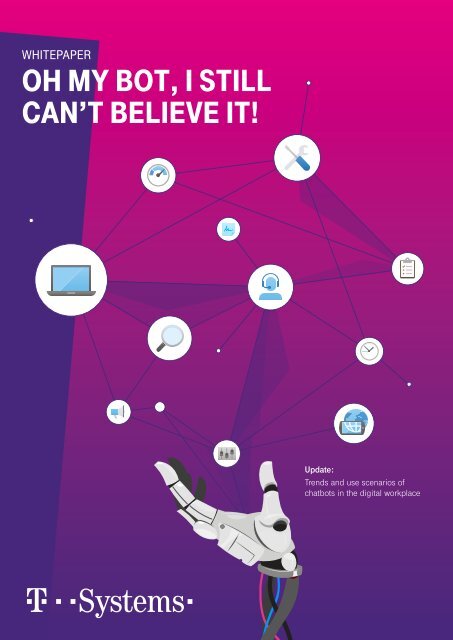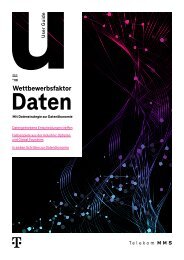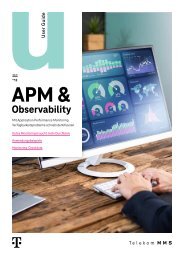Oh my Bot, I still can’t believe it
Create successful ePaper yourself
Turn your PDF publications into a flip-book with our unique Google optimized e-Paper software.
WHITEPAPER<br />
<strong>Oh</strong> <strong>my</strong> bot, I Still<br />
<strong>can’t</strong> <strong>believe</strong> <strong>it</strong>!<br />
Update:<br />
Trends and use scenarios of<br />
chatbots in the dig<strong>it</strong>al workplace
CONTENTS<br />
Introduction 5<br />
Current market developments 6<br />
Conversation w<strong>it</strong>h Gillian McCann about the potentials of chatbots 9<br />
BOTS IN THE DIGITAL WORKPLACE 12<br />
Human resource management 12<br />
IT service management 13<br />
Internal communication 14<br />
Software development 15<br />
How you get to your bot 16<br />
Get your chatbot in five steps 17<br />
Successful examples from customers 18<br />
OUTLOOK 21<br />
Imprint:<br />
Wh<strong>it</strong>epaper Publication February 2019<br />
T-Systems Multimedia Solutions GmbH<br />
Riesaer Strasse 5, 01129 Dresden, Germany<br />
Authors:<br />
Kevin Hähnlein<br />
Oliver Re<strong>it</strong>hage<br />
Organization:<br />
Project management: Isabel Uhle<br />
Layout: Peter Brücker
INTRODUCTION<br />
Our first wh<strong>it</strong>epaper on chatbots, which appeared in April 2017, has been in great demand. It<br />
presented use cases for bots along the customer journey and introduced the possibil<strong>it</strong>ies and<br />
potentials of a technology whose poignancy in the areas of dig<strong>it</strong>ization and IT has continued to<br />
increase in recent years. But what’s really behind a chatbot? In 2019, can we finally talk about<br />
artificial intelligence or is a chatbot just a cooler, algor<strong>it</strong>hm-based user interface? To what degree<br />
has the hype regarding offer and demand continued to evolve in the last two years?<br />
The aim of this wh<strong>it</strong>epaper is to investigate these questions and provide a current overview of<br />
the agile and growing market around conversational interfaces, in other words, chatbots and<br />
voice assistants. In add<strong>it</strong>ion, based on use scenarios for various company departments, <strong>it</strong><br />
shows how a chatbot can be used to reach the next level of a successfully established dig<strong>it</strong>al<br />
workplace in practice.<br />
KEVIN HÄHNLEIN<br />
SOCIAL BUSINESS TECHNOLOGY CONSULTANT<br />
... has worked in consulting for social business technology at<br />
T-Systems Multimedia Solutions since 2016 and guides companies<br />
in their trans<strong>it</strong>ion to a dig<strong>it</strong>al workplace. For his master’s thesis,<br />
the pol<strong>it</strong>ical scientist and economist has also conducted research<br />
on the influence of artificial intelligence on the process of pol<strong>it</strong>ical<br />
opinion formation.<br />
STRONGEST<br />
GROWTH<br />
Web chats and virtual<br />
assistants are the leading<br />
growth trends in the<br />
coming year (in<br />
Europe)<br />
69%<br />
of the companies project<br />
an increase in customer<br />
contacts that are processed<br />
fully automatically<br />
OLIVER REITHAGE<br />
MASTER’S DEGREE CANDIDATE, SOCIAL BUSINESS TECHNOLOGY<br />
... has worked at T-Systems Multimedia Solutions since 2017 as a<br />
working student and master’s degree candidate. The communications<br />
scientist is researching the automation of communication for<br />
his master’s thesis and is an expert in use scenarios for employee-oriented<br />
chatbot systems in the dig<strong>it</strong>al workplace.<br />
17%<br />
Phone communication in<br />
the last two years. Telephony<br />
is increasingly replaced<br />
by messenger services<br />
Source: http://www.ibusiness.de/aktuell/db/902403SUR.html<br />
25%<br />
Every fourth resident<br />
in Germany wants to<br />
use chatbots<br />
4 5
INTRODUCTION<br />
INTRODUCTION<br />
CURRENT MARKET DEVELOPMENTS<br />
Chatbots and voice assistants continue to be among the key topics in dig<strong>it</strong>ization and are increasingly<br />
prevalent in our everyday personal and business matters. Pioneers in China and the<br />
Un<strong>it</strong>ed States publish new breakthroughs on a weekly basis; in Germany, the start-up scene<br />
around chatbots is also growing steadily. The major players Microsoft and Google, which<br />
until recently observed the dynamic market w<strong>it</strong>h some reserve, began their first acquis<strong>it</strong>ions<br />
of successful software last year and can be expected to significantly push their free chatbot<br />
frameworks—Dialogflow and Virtual Assistant—in the near future.<br />
About the technology <strong>it</strong>self: When <strong>it</strong> comes to these conversational interfaces, the advancement<br />
of the graphical user interface (GUI), to what degree are we already dealing w<strong>it</strong>h artificial<br />
intelligence (AI) nowadays? AI has intrigued humans for decades and has received more or<br />
less attention in public discussion throughout the course of dig<strong>it</strong>al progress. At the moment, AI<br />
is again dominating many debates in business, pol<strong>it</strong>ics and science—and has long arrived in<br />
the personal life of any smartphone user who communicates w<strong>it</strong>h voice assistants such as Siri<br />
and Alexa or follows personalized recommendations for songs and shows by Spotify or Netflix.<br />
WHAT DOES (ARTIFICIAL) INTELLIGENCE MEAN?<br />
The inventor of the intelligence quotient, William Stern, defined intelligence as the “capac<strong>it</strong>y<br />
of an individual to consciously adapt his thinking to new requirements.” It is the “general<br />
mental adaptabil<strong>it</strong>y to the new tasks and cond<strong>it</strong>ions of life.” If, in turn, one follows the model<br />
of development levels first described by the Swiss biologist Jean Piaget in the late 1950s, four<br />
levels can be observed in the development of human intelligence: sensomotoric intelligence;<br />
the abil<strong>it</strong>y to imagine and speak; thinking ahead and planning; and abstract thinking that lets<br />
us develop hypotheses and analyze problems theoretically as well as systematically. It seems<br />
natural to transfer Stern’s defin<strong>it</strong>ion and Piaget’s development levels to the creation of artificial<br />
intelligence and smart machines when discussing the opportun<strong>it</strong>ies and potentials of new<br />
technologies like chatbots in a modern work environment.<br />
The aim of AI is to get computers to think and act like humans in areas in which humans do<br />
well and perform even better than machines. A study panel at Stanford Univers<strong>it</strong>y describes AI<br />
in this context as a science and collection of various computer technologies that are inspired<br />
by the human body and nervous system so they can learn to feel, reason and act. Rudolph,<br />
Syvikhin & Ebert call this phenomenon cogn<strong>it</strong>ive computing and simulate human behavior w<strong>it</strong>h<br />
auto-adaptive models. This is based on algor<strong>it</strong>hms that are seen as the fundamental element of<br />
computing and describe a series of computational steps which generate an output based on a<br />
given input. In other words: Algor<strong>it</strong>hms are computer codes that strive to solve computational<br />
problems.<br />
So these technologies enable computers or machines to perceive the world, collect information,<br />
analyze <strong>it</strong> and understand <strong>it</strong> through natural voice processing, make decisions and<br />
recommend procedures, as well as reflect on results and learn from them. All these are the key<br />
functions of a chatbot whose arch<strong>it</strong>ecture and various layers are presented generically in the<br />
text below.<br />
6 7
















